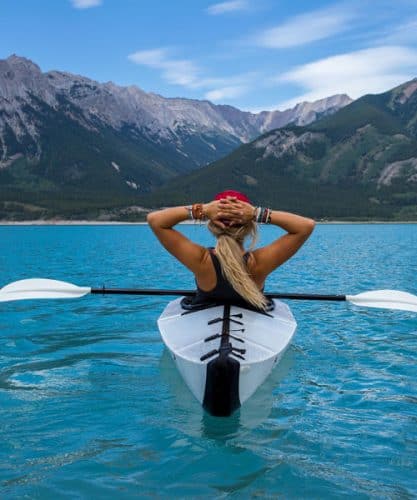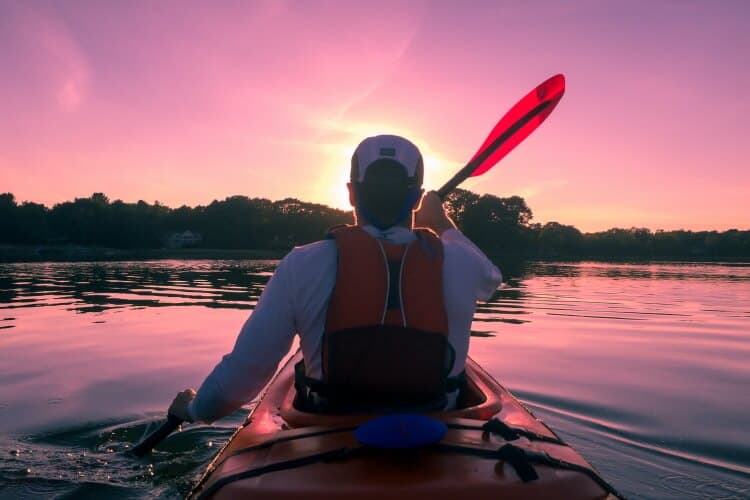If you know anything about kayaking or have been looking for the perfect kayak to buy for some time now, you know that there are many different options and designs available.
For a beginner, it may sound complicated but don’t worry:
I am here to tell you everything you need to know about buying a kayak, and you’ll be paddling away in no time!
First, let’s get started with the basics.
There are two main types of kayaks:
What is the difference between sit-on-top kayaks and sit-in kayaks?
Sit-on-top kayaks are very user-friendly:
They are wider and shorter than sit-in kayaks and thus more stable. They are very easy to get in and out of, and because they have an open deck rather than an enclosed one, they are perfect for bigger people too.
Sit-on-top kayaks are self-bailing, meaning they have small holes (called scupper holes) that drain the water.
All of these features make sit-on-top kayaks perfect for beginners and recreational paddling.
One thing that is important to note is that because sit on tops have an open deck, you will get wet. This means it’s better to use these types of kayaks in warmer environments and waters.
Sit-in kayaks vary more in size, shape, and purpose and are divided into two subcategories:
- Recreational sit-in kayaks
- Touring kayaks
Recreational sit-in kayaks are wider, shorter, and come with a big cockpit. They are stable and very easy to use.
Touring or sea kayaks are longer, narrower, and come with a much smaller cockpit. The cockpit shelters your lower body from the water and makes sit-in kayaks suitable for cooler weather and water conditions.
Now that you know the difference between the main types of kayaks, let’s move on to factors you should consider when choosing between a recreational or a sea kayak.
Use

Where and how you want to use your kayak will determine the type of boat you should buy:
- If you are just interested in recreational paddling, swimming, or diving off of your boat, a wide and stable sit-on-top or sit-in kayak will be a good choice.
- If you are into fishing, you might want to pick a specific fishing kayak, depending on your skills and needs.
- If you plan to spend a lot of time on the water and want to take (multi-)day trips, a touring kayak is the way to go.
Stability
Sit-on-tops and recreational sit-in kayaks are wider and more stable, making them perfect for beginners or paddling with children and pets. If you’re not that demanding, a recreational kayak will also be suitable for fishing.
Height/Length
Again, how long a kayak is right for you depends on your needs:
Shorter kayaks are easier to turn and maneuver, but because they are wider than other types of kayaks, they are considered to be slow.
Longer and narrower kayaks are faster and easier to paddle over long distances. They are also able to track (hold a straight line) better.
Don’t forget to think about how you plan to transport your kayak! A shorter kayak will be a more comfortable choice for obvious reasons.
Weight
Most sit-on-top kayaks are made of ABS plastic, which makes them very durable but heavy at the same time.
Sit-in kayaks are made of materials like roto-molded ABS plastic, fiberglass, carbon fiber, Kevlar, wood, and lighter-weight plastics. These materials generally make the kayaks significantly lighter but also less durable.
If you opt for an inflatable kayak, the weight will be no problem at all.
Modular kayaks are as durable and heavy as regular kayaks, but you can quickly snap them apart into two or three pieces that can easily be handled by one person.
Whether you’ll be able to manage your equipment by yourself is something very important to consider!
Dragging it down the beach may not be an issue, but lifting it over your head and onto the car might be. Knowing your limits will help ensure you’ll get the most out of your boat.
Weight Capacity
Every kayak has a recommended weight limit, but many people misunderstand that number.
You would expect that if a kayak’s maximum weight limit is 250 pounds, a 250-pound person could paddle it with no problems, right?
Wrong!
The capacity actually indicates the amount of weight a kayak can hold and still float – it says nothing about the performance.
If you’re as heavy as the recommended weight limit, a sit-in kayak would still hold up to the capacity, but instead of water draining out of the scupper holes, the water would come in. A sit-on-top kayak would be mostly underwater and almost impossible to paddle.
If you’re just out on the water for the fun of it, it’s not that big of a deal. However, if you prefer a drier and more comfortable paddling experience, you should take the weight limit seriously.
According to my research, you should aim to stay below 70-75% of the stated weight limit of any kayak.
And don’t forget to factor in the weight of your gear!
Kayak Depth
If you are more on the heavier side, make sure to check for sufficient depth to ensure you have enough space and room for your legs. Also, as already mentioned above, most sit-on-top and recreational sit-in kayaks can accommodate larger body types.
Wrapping it up
As you can see, there are many things to consider when it comes to choosing the right kayak, but when you are armed with the right kind of information, the process gets a lot easier.
Don’t get overwhelmed by the different brands and types available. Instead, narrow down your options by asking yourself how and where you’ll want to use your kayak.
I hope my kayak buying guide helps you find the boat that is right for you. If you have any questions or comments, please let me know below!








